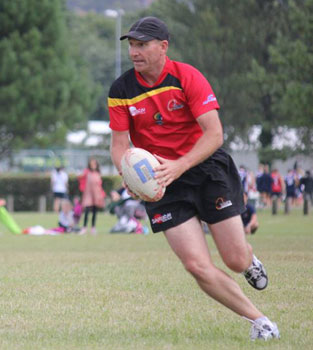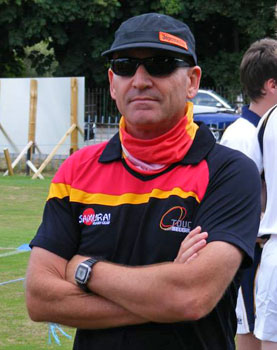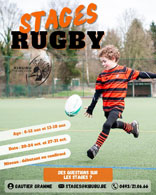Interpellé par la domination des équipes de l’hémisphère Sud lors de la dernière Coupe du monde et par cette phrase lourd de sens de Jonathan Davies (international gallois dans les années 1980-90 et désormais journaliste sportif à la BBC) « la pratique régulière du touch est un des secrets du succès des nations de l’hémisphère sud et particulièrement des All Blacks lors de cette dernière coupe du monde de rugby » (https://www.youtube.com/watch?v=gNc2aSSSlNw), nous avons décidé d’en savoir plus. L’équipe belge masculine de rugby Touch étant coachée par un Australien, Mathew Bannon, le choix était vite fait. Il répond en détail et en anglais.
 (Photo D.R.) |
Why is Touch undervalued in the northern hemisphere (Europe) compared to the southern hemisphere (e.g. Australia, N-Z) ?
Touch football is certainly one of the more popular sports played in Australasia. In Australia particularly, Touch is played by over a quarter of a million registered touch players, half a million school children and up to 100,000 casual players . While New Zealand has less touch players than Australia, it is actually the largest participation sport within their country and has over 230,000 players made up of about 70,000 under-17 year olds and about 160,000 adult players . Touch is also played in other Australasian countries such as Cook Islands, Fiji, Papua New Guinea, Samoa, and Vanuatu, that I know of.
In Australia and New Zealand it is very easy to find a competition to play Touch. Not only organized or association-based competition but on the east coast for example, you can find workers playing during lunch breaks, people (including families) in suburban parks on weekends, on beaches during summer, and many schools across Australia include Touch in physical education programmes. When I joined the army in 1981 there was organized competition against other regiments in the state. When I joined Customs and up until moving to Brussels in 2009, each city I worked in had a Customs team and annual competitions against the private sector colleagues. These games were in addition to the normal association competitions played almost every evening for juniors, men’s, women’s and mixed categories.
I can’t generalise for Australasia, but it is safe to say that the sports that Australians play today are the result of cultural evolution over the last two centuries . The desire to play and watch sport is central in Australian culture and this is not likely to change in the coming decades. According to one report, by the year 2040 “Australians will most likely still follow and participate in Australian Rules Football, cricket, rugby, netball, sailing, soccer, swimming, basketball, lawn bowls and Touch Football (as well as other sports) in large numbers” .
Maybe one response to why Touch is less valued in the northern hemisphere compared to the southern hemisphere is because the range of benefits playing Touch is not yet fully appreciated ?
Contrary to urban myths about the competitiveness of Australians and without knowing any scientific or social research, in my family and circle of friends, the reason we tend play sport is to keep fit rather than get fit to play sport. In 2010, 82.3% of Australians aged 15 and over participated at least once annually in physical activity for exercise, recreation or sport . In another study, the breakdown of athletes with high Body Mass Index (BMI) as a health risk identified that soccer athletes comprised 60.2% of obese athletes, rugby 27.3% and Touch Football 8.7% . Ooooh, very scientific. The more motivating factors for playing Touch are often far simpler.
My introduction to Touch was during the Australian Rules Football off-season. So in fact, as an adult I started quite late as a Touch player. Another example is my children’s case, where they took part in school and competitions during the soccer off-season.
 (Photo D.R.) |
Compared to other sports, Touch is great value for money in Australia. Registrations and subscription fees are often much lower than other competitive team sports. It is a game that requires little equipment ; sometimes only a ball is needed when played socially. Players only need very basic skills to play, which are to run, pass, catch and place the ball on the ground (roll-ball or scoring a touch-down). The basic rules are quite simple although become more complex to referee at the elite level due to the pace of games.
Because of the non-contact nature, Touch is a game for all ages, genders, shapes, sizes and standards. It is not uncommon to find whole families playing within the same competition or even the same team. Family members or friends who do not play or referee for whatever reason, do not need qualifications to be involved off the field. There are many opportunities to play in Australia and New Zealand with age and gender categories from 10 years old to 60 years old – different time slots obviously ! One of the other attractions is also that there are very low injury rates compared to other team sports. For the more serious players, playing can lead to travel and expanding networks of friends by competing far and wide, from national tournaments to international club and country tournaments.
There were quite a few references to Touch in the press and social media post-Rugby World Cup 2015. Not only journalists and pundits but legends such as Jonathan Davis and Shane Williams from Wales and Graham Henry, NZ 2011 coach. These guys and other commentators speculated that future rugby stars who play Touch grow up with a natural ability to catch and pass and find a gap. This matures into an instinctive ability to step, combine, or show ‘n go and most importantly gain the experience of reading the game. Turning to the science of things again, a study on small sized games (i.e. limited players on a team) resulted in finding that fewer players on larger field sizes elicit greater physiological and perceptual responses and time-motion demands . Necessary for Touch and maybe skills that translate to other sports beyond just rugby ?
A couple of conclusions based on the experience above are two essential elements.
First is start playing Touch as young as possible, e.g. primary school age. Forget the strategic desire to be successful at the national or international level for a moment. Remember it is a good safe sport that will build confidence, social skills and a healthy lifestyle. The second conclusion does lead to improving the standard and success and that is competition. There are four basic ingredients needed for competition. Number one is administration, two is a regular place to play, three is a pool of referees and four is of course players. Attracting more players can also lead to commercial interest. One avenue to attract new players and sponsors that Touch Belgium could explore in 2016 is using social media more. The web is already used to keep people informed about sporting events. However, the use of YouTube, smartphones and/or Facebook could showcase social and elite Belgian games, could create an opportunity for keeping and building communities around the sport and maybe lead to sports broadcasting.
One conclusion I would not draw for Belgium or the northern hemisphere is to simply try and imitate Australia or New Zealand. This is not saying we should ignore what the southern hemisphere does in the Touch universe. I recently had the privilege to coach the Belgian Men’s Open team and hope to be selected for the job again next year. Rather than design an Australian Touch team (or New Zealand, England, etc. team), it’s about building a Belgian identity and style of play. Last European championship we were about speed, technical quality and fitness. Next year, pending confirmations…we will add “space” to these three elements. The aim being to be in the top four in Europe !



